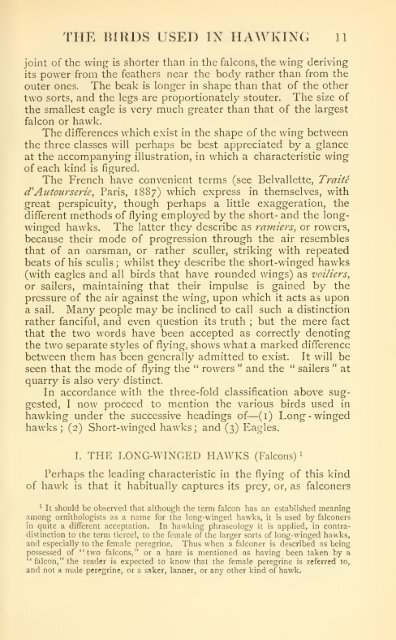- Page 2: I JONATHAN DWIGHTJr]
- Page 9: 321 THE ART AND PRACTICE OF HAWKING
- Page 13: PREFACE NOTWITHSTANDING the large n
- Page 16 and 17: X CONTENTS CHAPTER VI Training and
- Page 18 and 19: LIST OF ILLUSTRATIONS PHOTOGRAVURES
- Page 20 and 21: 2 ART AND PRACTICE OF HAWKING Roman
- Page 22 and 23: 4 ART AND PRACTICE OF HAWKING losin
- Page 24 and 25: 6 ART AND PRACTICE OF HAWKING by Ge
- Page 26 and 27: ; 8 ART AND PRACTICE OF HAWKING pub
- Page 28: 10 ART AND PRACTICE OF HAWKING syno
- Page 33 and 34: — THE BIRDS USED IN HAWKING 13 st
- Page 35 and 36: THE BIRDS USED IN HAWKING 15 The di
- Page 37 and 38: THE BIRDS USED IN HAWKING 17 moult
- Page 39 and 40: ; THE BIKDS USED IN HAWKING 19 abou
- Page 41 and 42: THE BIRDS USED IN HAWKING 2] Red-NA
- Page 43 and 44: THE BIRDS USED IN HAWKING 23 is a d
- Page 45 and 46: — THE BIRDS USED IN HAWKING 25 la
- Page 47 and 48: ; THE BIRDS USED IN HAWKING 27 liab
- Page 49 and 50: THE BIRDS USED IN HAWKING 29 Kestre
- Page 51: TRAiNr;n kesikki, • THrM){:KH()i,
- Page 54 and 55: 32 ART AND PRACTICE OF HAWKING the
- Page 56 and 57: 34 ART AND PRACTICE OF HAWKING hims
- Page 58 and 59: 36 ART AND PRACTICE OF HAWKING auth
- Page 60 and 61: 38 ART AND PRACTICE OF HAWKING othe
- Page 62 and 63: BEFORE CHAPTER III Furniture and Fi
- Page 65 and 66: FURNITURE AND FITTINGS 41 leg, is p
- Page 67 and 68: FURNITURE AND FITTINGS 43 perhaps u
- Page 69 and 70: FURNITURE AND FITTINGS 45 leash rou
- Page 71: HAWK'S FURMTURK, II. BLOCKS AND PER
- Page 74 and 75: 48 ART AND PRACTICE OF HAWKING of t
- Page 77 and 78: FURNITURE AND FITTINGS 49 the back
- Page 79 and 80:
FURNITURE AND FITTINGS 51 likely to
- Page 83 and 84:
FURNITURE AND P^ITTINGS 53 handy, e
- Page 85 and 86:
CHAPTER IV Eyesses and Hack Hawks E
- Page 87 and 88:
EYESSES AND HACK HAWKS 57 Once arri
- Page 89 and 90:
EYESSES AND HACK HAWKS 59 moderatel
- Page 91 and 92:
EYESSES AND HACK HAWKS 61 even of t
- Page 93 and 94:
; EYESSES AND HACK HAWKS 03 a scuff
- Page 95 and 96:
! EYESSES AND HACK HAWKS 65 tomed t
- Page 97 and 98:
— EYESSES AND HACK HAWKS 67 first
- Page 99 and 100:
EYESSES AND HACK HAWKS GO It seemed
- Page 101 and 102:
PASSAGE HAWKS 71 But, as a rule, th
- Page 103 and 104:
PASSAGE HAWKS 73 complete. On each
- Page 105 and 106:
PASSAGE HAWKS 75 Into that open hee
- Page 107 and 108:
; PASSAGE HAWKS 11 ing her to sleep
- Page 109 and 110:
PASSAGE HAWKS 79 merlin. If he can
- Page 111 and 112:
PASSAGE HAWKS 81 biting, stroking h
- Page 113 and 114:
PASSAGE HAWKS 83 training, the gran
- Page 115 and 116:
PASSAGE HAWKS 85 their nature, beco
- Page 119 and 120:
WE CHAPTER VI Training and Entering
- Page 121 and 122:
TRAINING AND ENTERING 89 pieces, as
- Page 123 and 124:
I TRAINING AND ENTERING 91 of a for
- Page 125 and 126:
a TRAINING AND ENTERING 93 temptati
- Page 127 and 128:
TRAINING AND ENTEllING 95 deception
- Page 129 and 130:
TRAINING AND ENTERING 97 all these
- Page 131 and 132:
TRAINING AND ENTERING 99 habit of i
- Page 133 and 134:
CHAPTER VII Rook- Hawking EYESSES,
- Page 135 and 136:
ROOK-HAWKING 103 ship's mind the be
- Page 137 and 138:
ROOK-HAWKING 105 by some deadly ene
- Page 139 and 140:
ROOK-HAWKING 107 rook shapes his co
- Page 141 and 142:
ROOK-HAWKING 109 them ; but many bi
- Page 143:
^ 1
- Page 146 and 147:
112 ART AND PRACTICE OF HAWKING saf
- Page 148 and 149:
114 ART AND PRACTICE OF HAAVKING re
- Page 150 and 151:
116 ART AND PRACTICE OF HAAVKING mo
- Page 152 and 153:
118 Al^T AND PTJACTTCE OF HAWKING i
- Page 154 and 155:
120 ART AND PRACTICE OF HAWKING in
- Page 156 and 157:
" hawk's attention and to cheer her
- Page 158 and 159:
124 ART AND PRACTICE OF HAWKING the
- Page 160:
" 126 ART AND PRACTICE OF HAWKING i
- Page 164 and 165:
128 ART AND PRACTICE OF HAAVKING he
- Page 166 and 167:
THE CHAPTER IX Lark- Hawking merlin
- Page 168 and 169:
132 ART AND PRACTICE OF HAWKING ext
- Page 171 and 172:
LARK-HAWKING 133 her into condition
- Page 173 and 174:
LARK-HAWKING 135 your hand, well ga
- Page 175 and 176:
I.ARK-HAWKING 137 form shown by a l
- Page 177 and 178:
LARK-HAWKING 139 short work of the
- Page 179 and 180:
JLARK-HAWKING 141 If you throw off
- Page 181 and 182:
GULLS, HERON, KITE, DUCK, ETC. 143
- Page 183 and 184:
GULLS, HERON, KITE, DUCK, ETC. 145
- Page 185 and 186:
GULLS, HERON, KITE, DUCK, ETC. 147
- Page 187 and 188:
GULLS, HERON, KITE, DUCK, ETC. 149
- Page 189 and 190:
THE GOSHAWK 151 doubtful about the
- Page 191 and 192:
THE GOSHAWK 153 twenty times in ten
- Page 193 and 194:
THE GOSHAWK 155 at hares rather ove
- Page 195 and 196:
THE GOSHAWK 157 full-grown rabbit ;
- Page 198 and 199:
TRAINED GOSHAWK "GAIETY GAL' OWNED
- Page 200 and 201:
THERE CHAPTER XII The Sparrow- Hawk
- Page 202 and 203:
162 ART AND PRACTICE OF HAWKING sho
- Page 204 and 205:
164 ART AND PRACTICE OF HAWKING for
- Page 206 and 207:
166 ART AND PRACTICE OF HAWKING cla
- Page 208:
— — : 168 ART AND PRACTICE OF H
- Page 212 and 213:
CHAPTER XIII Home Life PROBABLY the
- Page 214 and 215:
172 ART AND PRACTICE OF HAWKING dem
- Page 216 and 217:
174 ART AND PRACTICE OF HAWKING of
- Page 218 and 219:
176 ART AND PRACTICE OF HAWKING so
- Page 220 and 221:
178 ART AND PRACTICE OF HAWKING cle
- Page 222 and 223:
180 ART AND PRACTICE OF HAWKING she
- Page 224 and 225:
182 ART AND PRACTICE OF HAWKING sho
- Page 226 and 227:
— 184 ART AND PRACTICE OF HAWKING
- Page 228 and 229:
; 18G ART AND PRACTICE OF HAWKING m
- Page 230 and 231:
188 ART AND PRACTICE OF HAWKING to
- Page 232 and 233:
190 ART AND PRACTICE OF HAWKING whe
- Page 234 and 235:
HALF CHAPTER XIV Hawks in the Field
- Page 236 and 237:
194 ART AND PRACTICE OF HAWKING if
- Page 238 and 239:
196 ART AND PRACTICE OF HAWKING mis
- Page 240 and 241:
198 AKT AXD PRACTICE OF HAWKING roo
- Page 242 and 243:
! 200 ART AND PRACTICE OF HAWKING a
- Page 244 and 245:
—; 202 ART AND PRACTICE OF HAWKIN
- Page 246 and 247:
204 ART AND PRACTICE OF HAWKING but
- Page 248 and 249:
206 ART AND PRACTICE OF HAWKING her
- Page 250 and 251:
208 ART AND PRACTICE OF HAWKING The
- Page 252 and 253:
210 ART AND PRACTICE OF HAWKING Tho
- Page 254 and 255:
— 212 ART AND PRACTICE OF HAWKING
- Page 256 and 257:
214 ART AND PRACTICE OF HAWKING red
- Page 258 and 259:
21 G ART AND PRACTICE OF HAWKING af
- Page 260 and 261:
218 ART AND PRACTICE OF HAWKING the
- Page 262 and 263:
220 ART AND PRACTICE OF HAWKING bee
- Page 264 and 265:
222 ART AND PRACTICE OF HAWKING car
- Page 266 and 267:
224 ART AND PRACTICE OF HAWKING mos
- Page 268 and 269:
226 ART AND PRACTICE OF HAWKING haw
- Page 270 and 271:
228 ART AND PRACTICE OF HAWKING war
- Page 272 and 273:
230 ART AND PRACTICE OF HAWKING mou
- Page 274 and 275:
232 ART AND PRACTICE OF HAWKING bet
- Page 276 and 277:
234 ART AND PRACTICE OF HAWKING whi
- Page 278 and 279:
236 ART AND PRACTICE OF HAWKING A t
- Page 280 and 281:
238 ART AND PRACTICE OF HAWKING in
- Page 282 and 283:
240 ART AND PRACTICE OF HAWKING inf
- Page 284 and 285:
242 ART AND PRACTICE OF HAWKING est
- Page 286 and 287:
A MOST CHAPTER XVII Moulting import
- Page 288 and 289:
246 ART AND PRACTICE OF HAWKING tha
- Page 290 and 291:
248 ART AND PRACTICE OF HAWKING wei
- Page 292 and 293:
250 ART AND PRACTICE OF HAWKING rea
- Page 294 and 295:
252 ART AND PRACTICE OF HAWKING unw
- Page 296 and 297:
254 ART AND PRACTICE OF HAWKING dos
- Page 298 and 299:
256 ART AND PRACTICE OF HAWKING det
- Page 300 and 301:
258 ART AND PRACTICE OF HAWKING sel
- Page 302 and 303:
260 ART AND PRACTICE OF HAWKING Hag
- Page 304 and 305:
262 ART AND PRACTICE OF HAWKING dev
- Page 306 and 307:
264 ART AND PRACTICE OF HxVAVKING f
- Page 308 and 309:
— 266 ART AND PRACTICE OF HAWKING
- Page 310 and 311:
— 268 ART AND PRACTICE OF HxVWKIN
- Page 312 and 313:
270 ART AND PRACTICE OF HAWKING tha
- Page 314 and 315:
272 ART AND PRACTICE OF HAWKING ref
- Page 316 and 317:
a; 274 ART AND PRACTICE OF HAWKING
- Page 318 and 319:
276 ART AND PRACTICE OF HAWKING ple
- Page 320 and 321:
— 278 ART AND PKACTICE OF HAWKING
- Page 322 and 323:
280 ART AND PRACTICE OF HAWKING or
- Page 324 and 325:
—; 282 ART AND PRACTICE OF HAWKIN
- Page 326 and 327:
284 AUT AND PRACTICE OF HAWKING law
- Page 328 and 329:
286 INDEX Carelessness, 213 Carryin
- Page 330 and 331:
288 INDEX 1 " Kismet," eyess tierce
- Page 332 and 333:
290 INDEX Small birds, 29, 187 Snar
- Page 334:
PRINTED BY MORRISON AND GIBB LIMITE

















